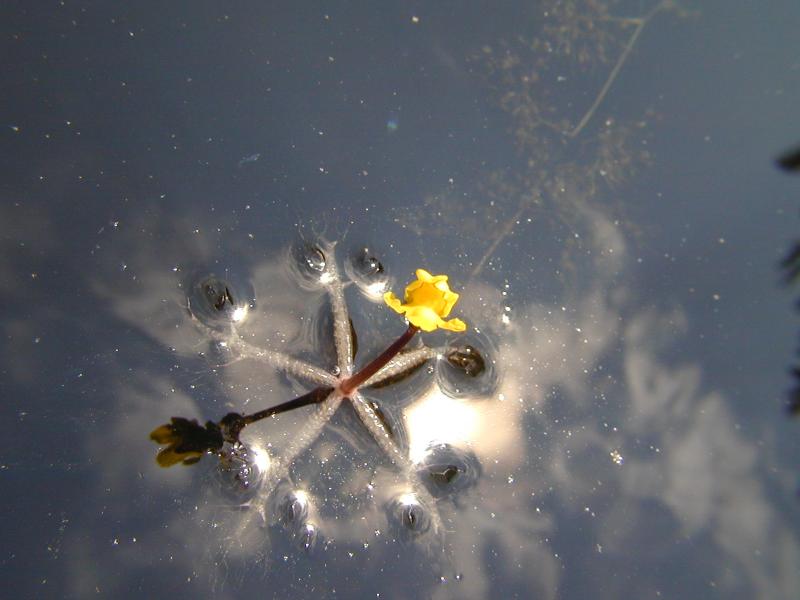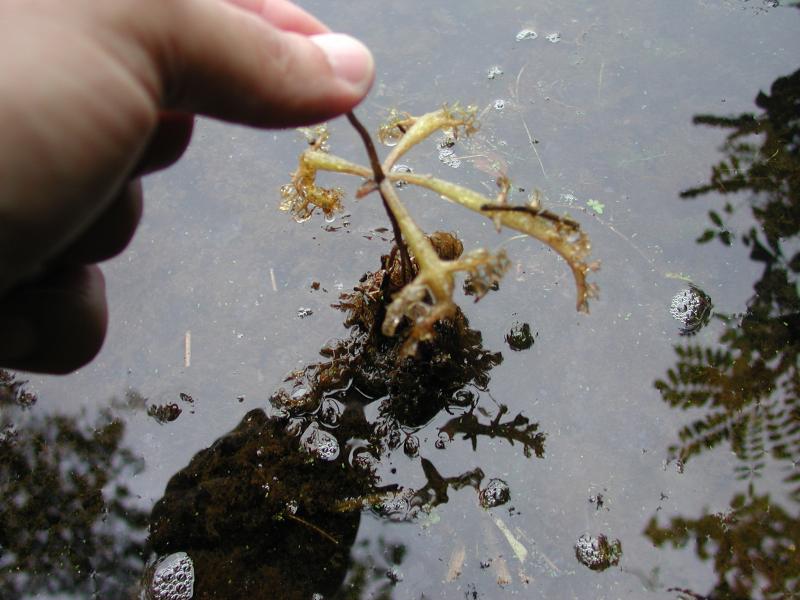Small Swollen Bladderwort
Utricularia radiata Small
- Class
- Dicotyledoneae (Dicots)
- Family
- Lentibulariaceae (Bladderwort Family)
- State Protection
- Threatened
Listed as Threatened by New York State: likely to become Endangered in the foreseeable future. For animals, taking, importation, transportation, or possession is prohibited, except under license or permit. For plants, removal or damage without the consent of the landowner is prohibited.
- Federal Protection
- Not Listed
- State Conservation Status Rank
- S2
Imperiled in New York - Very vulnerable to disappearing from New York due to rarity or other factors; typically 6 to 20 populations or locations in New York, very few individuals, very restricted range, few remaining acres (or miles of stream), and/or steep declines.
- Global Conservation Status Rank
- G4
Apparently Secure globally - Uncommon in the world but not rare; usually widespread, but may be rare in some parts of its range; possibly some cause for long-term concern due to declines or other factors.
Summary
Did you know?
This is one of the few plants in the state where there are fewer historical records than existing populations. Once targeted surveys got underway in the 1980s many new populations were found. The genus name means little bladder while the species name comes from the floating leaves which radiate in all directions (Fernald, 1970).
State Ranking Justification
There are 23 existing populations and 13 are ranked good to excellent in quality. The remaining populations contain fewer than 50 plants each. There are no additional historical records which have not been found or surveyed. This is one of the few rare plants that have more current records than historical records.
Short-term Trends
Many populations have been rechecked at least once and populations seem stable.
Long-term Trends
This is one of the few species that has more current populations than historical records and seems to be expanding its numbers in the state. Climate change may make more water bodies available for colonization.
Conservation and Management
Threats
Invasive aquatic plants like Cabomba, fan-wort, and Myriophyllum spicatum, Eurasian water milfoil, could outcompete this species. The use of copper sulfate could kill plants. When the ponds are dried out improper use by ATVs, horses and people fishing could damage plants.
Conservation Strategies and Management Practices
Preserve vegetated buffers around ponds and prevent polluted runoff or herbicides from impacting water quality.
Research Needs
Research is needed to determine how populations are being affected by invasive aquatic plants. More frequent monitoring of ponds could show how populations fluctuate from year-to-year. Surveys of ponds north of its range could determine if it is expanding northward as climate changes.
Habitat
Habitat
In New York most sites for this species are small, shallow ponds, often surrounded by pine barrens. However it also has been discovered in artificial pools, gravel pits, and beaver ponds, including some sites that are eutrifying and/or dominated by exotics (New York Natural Heritage Program 2007). Ponds and sluggish waters (Fernald 1970). In ponds along or near coastal plain (Gleason & Cronquist 1991). Ponds, lakes, swamps, and drainage ditches (Garrett et al 2000).
Associated Ecological Communities
- Coastal plain pond
(guide)
The aquatic community of the permanently flooded portion of a coastal plain pond with seasonally, and annually fluctuating water levels. These are shallow, groundwater-fed ponds that occur in kettle-holes or shallow depressions in the outwash plains south of the terminal moraines of Long Island, and New England. A series of coastal plain ponds are often hydrologically connected, either by groundwater, or sometimes by surface flow in a small coastal plain stream.
- Eutrophic pond
(guide)
The aquatic community of a small, shallow, nutrient-rich pond. The water is usually green with algae, and the bottom is mucky. Eutrophic ponds are too shallow to remain stratified throughout the summer; they are winter-stratified, monomictic ponds.
- Pine barrens vernal pond*
(guide)
A seasonally fluctuating pond and its associated wetlands that typically occurs in pine barrens. The water is intermittent, usually a pond in the spring but sometimes losing water through the summer to become a mostly vegetated wetland at the end of the summer. These ponds and wetlands may be small.
* probable association but not confirmed.
Associated Species
- Brasenia schreberi (water-shield)
- Coreopsis rosea (pink coreopsis, pink tickseed)
- Eleocharis robbinsii (Robbins's spike-rush)
- Eriocaulon aquaticum (northern pipewort, northern hat-pins)
- Euthamia caroliniana (slender flat-topped-goldenrod)
- Glyceria canadensis (rattlesnake manna grass)
- Gratiola aurea (golden hedge-hyssop)
- Juncus canadensis (Canada rush)
- Juncus militaris (bayonet rush)
- Juncus pelocarpus (brown-fruited rush)
- Nymphaea odorata
- Phragmites australis (old world reed grass, old world phragmites)
- Rhexia virginica (Virginia meadow-beauty)
- Rhynchospora capillacea (hair beak sedge)
- Scirpus cyperinus (common wool-grass)
- Typha latifolia (wide-leaved cat-tail)
Range
New York State Distribution
Nearly all the historical records for this species are from Long Island, but in the last 20 years it has been discovered in Orange, Westchester, and Hamilton Counties as well.
Global Distribution
Utricularia radiata ranges along the Atlantic Coast from Nova Scotia and New Brunswick south to Florida, and further inland south and west from Georgia and Tennesse to Texas, Oklahoma, and Arkansas. It is also disjunct to Indiana.
Identification Comments
General Description
Utricularia radiata is a floating-leaved aquatic plant, carnivorous by means of the tiny bladders which the genus is named for. The plants do not root at all, but float or hang suspended in the water column (collapsing into an unruly tangle in one's hand when lifted out of the water). There are two quite different types of leaves. The lower leaves are alternate, up to 3 cm long, and divided many times into hair-like segments, each bearing many tiny bladders. The upper leaves immediately below the flowering stem are in whorls of 4-7, 1-4 cm long, and obviously inflated, and serve as "floats" so that the infloresence rides above the water surface. The flowers are yellow and 2-lipped, the lower lip 3-lobed, and occur on erect stalks in groups of (1) 3-4 (5) (Garrett et al 2000).
Best Life Stage for Proper Identification
This species is most easily identified when in flower.
Similar Species
Utricularia inflata is the only other species of bladderwort in New York with inflated whorls of leaves. It is a larger or more robust plant in most respects. The floats (pedicels) are 3-8 cm long, there are (3) 9-14 (18) flowers per infloresence, and the flowering stalk bends downward.
Best Time to See
Utricularia radiata flowers from mid-June through September.
- Vegetative
- Flowering
The time of year you would expect to find Small Swollen Bladderwort vegetative and flowering in New York.
Small Swollen Bladderwort Images
Taxonomy
Small Swollen Bladderwort
Utricularia radiata Small
- Kingdom Plantae
- Phylum Anthophyta
- Class Dicotyledoneae
(Dicots)
- Order Scrophulariales
- Family Lentibulariaceae (Bladderwort Family)
- Order Scrophulariales
- Class Dicotyledoneae
(Dicots)
- Phylum Anthophyta
Additional Common Names
- Small Floating Bladderwort
Synonyms
- Utricularia inflata ssp. radiata (Small) Stone
- Utricularia inflata var. minor Chapman
Additional Resources
Best Identification Reference
Schnell, Donald E. 2002. Carnivorous Plants of the United States and Canada. Second edition. Timber Press, Portland, Oregon.
Other References
Clemants, Steven and Carol Gracie. 2006. Wildflowers in the Field and Forest. A Field Guide to the Northeastern United States. Oxford University Press, New York, NY. 445 pp.
Crow, Garrett E. and C. Barre Hellquist. 2000. Aquatic and Wetland Plants of Northeastern North America: A revised and enlarged edition of Norman C. Fassett's a Manual of Aquatic Plants. Volume One: Pteridophytes, Gymnosperms, and Angiosperms: Dicotyledons. The University of Wisconsin Press. Madison, Wisconsin. 536 Pages.
Fernald, M.L. 1950. Gray's manual of botany. 8th edition. D. Van Nostrand, New York. 1632 pp.
Gleason, Henry A. and A. Cronquist. 1991. Manual of Vascular Plants of Northeastern United States and Adjacent Canada. The New York Botanical Garden, Bronx, New York. 910 pp.
Haines, Arthur and Thomas F. Vining. 1998. Flora of Maine. A Manual for Identification of Native and Naturalized Vascular Plants of Maine.
Holmgren, Noel. 1998. The Illustrated Companion to Gleason and Cronquist's Manual. Illustrations of the Vascular Plants of Northeastern United States and Adjacent Canada. The New York Botanical Garden, Bronx, New York.
New York Natural Heritage Program. 2010. Biotics database. New York Natural Heritage Program. New York State Department of Environmental Conservation. Albany, NY.
New York Natural Heritage Program. 2024. New York Natural Heritage Program Databases. Albany, NY.
Ogden, E.C. 1974. Anatomical patterns of some aquatic vascular plants of New York. New York State Museum Bull. 424.
Rhoads, Ann F. and Timothy A. Block. 2000. The Plants of Pennsylvania, an Illustrated Manual. University of Pennsylvania Press, Philadelphia, PA.
Taylor, Norman. 1915. Flora of the vicinity of New York. Memoirs of the New York Botanical Garden vol. V. New York, NY.
Voss, Edward G. 1996. Michigan Flora Part III. Dicots Concluded (Pyrolaceae - Compositae). Cranbrook Institute of Science Bulletin 61 and University of Michigan Herbarium. 622 pp.
Weldy, T. and D. Werier. 2010. New York flora atlas. [S.M. Landry, K.N. Campbell, and L.D. Mabe (original application development), Florida Center for Community Design and Research http://www.fccdr.usf.edu/. University of South Florida http://www.usf.edu/]. New York Flora Association http://newyork.plantatlas.usf.edu/, Albany, New York
Weldy, Troy W. and David Werier. 2005. New York Flora Atlas. [S.M. Landry, K.N. Campbell, and L.D. Mabe (original application development), Florida Center for Community Design and Research. University of South Florida]. New York Flora Association, Albany, NY. Available on the web at (http://newyork.plantatlas.usf.edu/).
Links
About This Guide
Information for this guide was last updated on: December 30, 2008
Please cite this page as:
New York Natural Heritage Program. 2024.
Online Conservation Guide for
Utricularia radiata.
Available from: https://guides.nynhp.org/small-floating-bladderwort/.
Accessed July 27, 2024.

